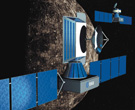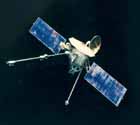|
|
Planet Mercury
Tweet
Planet Mercury
 Image taken by Messenger on its approach to Mercury
Image taken by Messenger on its approach to Mercury
"Spider" Impact crater
 Strange looking crater imaged by Messenger
Strange looking crater imaged by Messenger
Planet Mercury Facts
- Mercury is the planet nearest the sun. It has a diameter of 3,032 miles (4,879 km), about two-fifths of Earth's diameter.
- The planet orbits the sun at an average distance of about 36 million miles (58 million km), compared with about 93 million miles (150 million kilometers) for Earth.
- It is dry, extremely hot, and almost airless.
- The sun's rays are approximately seven times as strong on Mercury as they are on the Earth.
- The sun also appears about 2 1/2 times larger in the sky compared to how we see the sun on Earth.
- Scans of the planet made by Earth-based radar indicate that craters at its poles contain water ice.
- It travels round the sun faster than any other planet, taking only 88 days to make a full orbit of the sun.
- The planet rotates on its axis extremely slowly, taking 59 days compared to Earth's 24 hours.
- The planet is often very difficult to see in the night sky with the naked eye.
Mercury's Surface
Its surface appears to be much like that of the moon. It is covered by a thin layer of minerals called silicates in the form of tiny particles.
It has many deep craters and flat plains but unlike the moon it has steep cliffs.
Mercury's Atmosphere
The planet has very little atmosphere, only tiny amounts of helium, hydrogen, oxygen and sodium. Because of the lack of atmosphere Mercury's sky is black with stars being visible during the day.
Mercury's Temperature
Mercury doesn't have enough atmosphere to protect it from the sun's rays. The temperature on the planet may reach 450C (840F) during the day but at night the temperature may drop as low as -170C (-275F).
Moons, Name and Life

The cratered surface of Mercury.
Moons & Origin of Name
Mercury has no moons.
The Romans named the planet after the messenger to the gods.
Life on Mercury
It is improbable that any form of life could exist in the harsh conditions.
Is Mercury Just Like the Moon?
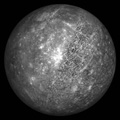
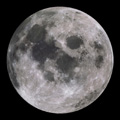
Images and Video
Crater impact


Messenger images of Mercury
Mercury passing the sun
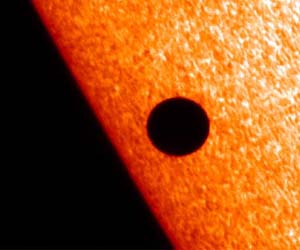

Future and Past Missions to Mercury
|
Planet Mercury Statistics
Comparison with Earth
|
Diameter: 3,032 miles (4,880 km)
Average Distance from Sun: 36 million miles (58 million km)
Orbital Period: 88 days
Rotation Period: 59 days
Maximum Surface Temperatures: 450C (840F)
Minimum Surface Temperatures: -170C (-275F)
Gravity: 3.7 m/s2 (38% Earth's Gravity)
Density: 5.427 g/cm3 (98.4% Earth's Density)
Mass: 3.3022 x 1023 kg (5.5% Earth's Mass)
Volume: 6.08272 x 1010 km3 (5.6% Earth's Volume)
Atmosphere: 42% Molecular oxygen, 29.0% sodium, 22.0% hydrogen, 6.0% helium, 0.5% potassium, Trace amounts of argon, nitrogen, carbon dioxide, water vapor, xenon, krypton and neon.
Average Distance from Sun: 36 million miles (58 million km)
Orbital Period: 88 days
Rotation Period: 59 days
Maximum Surface Temperatures: 450C (840F)
Minimum Surface Temperatures: -170C (-275F)
Gravity: 3.7 m/s2 (38% Earth's Gravity)
Density: 5.427 g/cm3 (98.4% Earth's Density)
Mass: 3.3022 x 1023 kg (5.5% Earth's Mass)
Volume: 6.08272 x 1010 km3 (5.6% Earth's Volume)
Atmosphere: 42% Molecular oxygen, 29.0% sodium, 22.0% hydrogen, 6.0% helium, 0.5% potassium, Trace amounts of argon, nitrogen, carbon dioxide, water vapor, xenon, krypton and neon.
Diameter: 7,926 miles (12,756 km)
Average Distance from Sun: 93 million miles (150 million km)
Orbital Period: 365.24 days
Rotation Period: 23.934 hours
Maximum Surface Temperatures: 58C (136F)
Minimum Surface Temperatures: -88C (-126F)
Gravity: 9.766 m/s2
Density: 5.515 g/cm3
Mass: 5.9737 x 1024 kg
Volume: 1.0832 x 1012 km3
Atmosphere: 78.08% nitrogen, 20.95% oxygen, 0.93% argon, 0.038% carbon dioxide, water vapor makes up around 0.4% of Earth's atmosphere depending on climatic conditions.
Average Distance from Sun: 93 million miles (150 million km)
Orbital Period: 365.24 days
Rotation Period: 23.934 hours
Maximum Surface Temperatures: 58C (136F)
Minimum Surface Temperatures: -88C (-126F)
Gravity: 9.766 m/s2
Density: 5.515 g/cm3
Mass: 5.9737 x 1024 kg
Volume: 1.0832 x 1012 km3
Atmosphere: 78.08% nitrogen, 20.95% oxygen, 0.93% argon, 0.038% carbon dioxide, water vapor makes up around 0.4% of Earth's atmosphere depending on climatic conditions.
